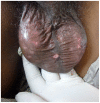Cutaneous manifestations of spotted fever rickettsial infections in the Central Province of Sri Lanka: a descriptive study
- PMID: 25232837
- PMCID: PMC4169373
- DOI: 10.1371/journal.pntd.0003179
Cutaneous manifestations of spotted fever rickettsial infections in the Central Province of Sri Lanka: a descriptive study
Abstract
Background: Characteristic skin lesions play a key role in clinical diagnosis of spotted fever group rickettsioses and this study describes these cutaneous manifestations along with basic histological features.
Methods and findings: Study was conducted at Medical Unit, Teaching Hospital, Peradeniya, from November 2009 to October 2011, where a prospective data base of all rickettsial infections is maintained. Confirmation of diagnosis was made when IgM and IgG immunofluorescent antibody titre of 1/32 and >1/256 respectively. Of the 210 clinical cases, 134 had cutoff antibody titers for Rickettsia conorii antigen for confirmation. All these 134 patients had fever and skin rash, and of them 132(98%) had discrete maculopapular rash while eight (6%) had fern leaf type skin necrosis. Eight patients (6%) had healed tick bite marks. Average size of a skin lesion was 5 mm and rash involved 52% of body surface, distributed mainly in limbs and back of the chest. Generally the facial and leg skin was slightly oedematous particularly in old aged patients. Sixteen patients (12%) had pain and swelling of ankle joints where swelling extended to feet and leg. Biopsies from skin rash of six patients showed evidence of cutaneous vasculitis and of them, 247 bp region of the 17-kDa spotted fever group specific protein antigen was amplified using PCR.
Conclusions: A discrete maculopapular rash and occasional variations such as fern leaf shape necrosis and arthritis are found in spotted fever group. Histology found vasculitis as the pathology of these lesions.
Conflict of interest statement
The authors have declared that no competing interests exist.
Figures







References
-
- Kularatne SA, Edirisingha JS, Gawarammana IB, Urakami H, Chenchittikul M, et al. (2003) Emerging rickettsial infections in Sri Lanka: the pattern in the hilly Central Province. Trop Med Int Health 8 (6) 803–811. - PubMed
-
- Premaratna R, Loftis AD, Chandrasena TG, Dasch GA, de Silva HJ (2008) Rickettsial infections and their clinical presentations in the Western Province of Sri Lanka: a hospital-based study. Int J Infect Dis 12 (2) 198–202. - PubMed
-
- Kularatne SAM, Rajapakse RPVJ, Wickramasinghe WMRS, Nanayakkara DM, Budagoda SS, et al. (2013) Rickettsioses in the central hills of Sri Lanka: serological evidence of increasing burden of spotted fever group. Int J Infect Dis 17 (11) e988–992. - PubMed
-
- Walker DH (1995) Rocky Mountain spotted fever: A seasonal alert. Clin Infect Dis 20: 1111–1117. - PubMed
Publication types
MeSH terms
Substances
LinkOut - more resources
Full Text Sources
Other Literature Sources
Medical

